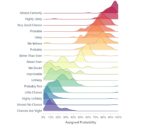
by tyler garrett | May 25, 2025 | Data Visual
In an era where decision-making increasingly hinges upon data-driven insights, clearly communicating uncertainty is essential. Without effectively visualizing uncertainty, stakeholders can make costly choices based on misleading confidence. Every piece of data carries a level of uncertainty—variables, measurement errors, predictive models—and visualizing this uncertainty ensures transparency, supports responsible analysis, and empowers informed decision-making. At the intersection of analytics, strategy, and innovation, our expertise helps organizations realistically assess uncertainties and confidently navigate complex scenarios. Let’s delve into proven techniques to effectively visualize uncertainty, transforming ambiguous datasets into actionable intelligence for your organization.
Why Visualizing Uncertainty Matters
Decision-makers often rely heavily on data visualizations to interpret complex datasets and identify actionable insights. However, visualizing uncertainty frequently receives less attention, even though it is crucially important in all forms of data analytics. When uncertainty isn’t explicitly visualized, it risks being overlooked entirely, potentially misleading stakeholders into misplaced confidence. Clear depictions of uncertainty convey data maturity and integrity, enhancing trust among executives, analysts, and stakeholders alike.
Representing uncertainty visually acknowledges the inherent limitations of predictive modeling and analytics. Properly presented uncertainty helps stakeholders better gauge reliability, make nuanced assessments, and set realistic business expectations. For example, in our experience with cross-pipeline data sharing and exchange formats, accurately visualizing potential uncertainty facilitates collaboration and reduces confusion across departments, ultimately improving organizational agility.
Additionally, clearly visualizing uncertainty can enhance ethical data practices. When analysts transparently communicate uncertainty, stakeholders develop a deeper awareness of inherent limitations and biases becoming better-informed decision-makers. This fosters responsible and ethical decision-making across all levels of your organization and helps avoid pitfalls addressed in ethical considerations of data analytics.
Common Sources of Uncertainty in Data Analytics
Before visualizing uncertainty effectively, you must first pinpoint its sources clearly. Several common uncertainty types inherently emerge across analytics workflows:
Measurement Errors and Data Collection Biases
Measurement inaccuracies or biases during data collection contribute significantly to uncertainty. Sensor inaccuracies, human input errors, and inconsistent reporting methods influence raw data integrity. Such errors can magnify downstream effects, leading to biased conclusions. Being aware of these measurement challenges allows us to transparently represent them when visualizing data. Precise documentation of these errors supports healthier discussions among stakeholders, clearly communicating potential data reliability challenges upfront.
Model-Based Predictive Uncertainty
Predictive analytics inherently contain uncertainty. Predictive models, by definition, rely on incomplete historic data, theoretical assumptions, and projections of future scenarios. Clearly visualizing statistical confidence and uncertainty ranges allows stakeholders to understand exactly how seriously to interpret predictions—protecting teams from overly confident assumptions or rash decisions.
For instance, organizations benefiting from our PostgreSQL consulting services routinely encounter predictive uncertainty as datasets evolve rapidly. Establishing effective practices to visualize predictive uncertainty aids decision-makers in understanding proprietary insights clearly—and, more importantly, realistically.
Techniques for Visualizing Uncertainty Effectively
Error Bars and Confidence Intervals
Error bars and confidence intervals are among the most common visualization techniques for showcasing uncertainty. These straightforward yet powerful visualizations communicate statistical variability clearly around specific data points, averages, or trends. Using error bars establishes visual reminders of uncertainty around mean values, providing decision-makers the context they need when leveraging analytics. This simplicity makes them ideal for executive presentations and dashboards, clearly visualizing potential data fluctuations without overwhelming viewers with excessive complexity.
Probability Density Functions and Violin Plots
Probability density functions (PDF) and violin plots offer more nuanced ways to visualize uncertainty, displaying the full range of possible values rather than mere central tendencies. Violin plots—they cleverly combine boxplots with kernel density plots—graphically highlight data distribution complexity. PDFs, commonly employed in simulation scenarios or predictive analytics, offer specific visualizations of probability distributions, thereby contextualizing predictions among uncertainty. Both methods go beyond simple summary statistics and effectively portray underlying data complexity, enabling stakeholders to interpret analytics responsibly and accurately.
Color Gradients, Opacity Variations and Heatmaps
Color gradients and opacity variations greatly enhance audiences’ intuitive understanding of uncertainty across large-scale datasets and complex visualizations. For example, displaying geospatial data or complex location analytics with uncertainty metrics utilizing heatmaps can effectively visualize variations in measurement confidence. Learning more about spatio-temporal indexing for location intelligence allows teams to fully leverage geospatial visualizations, helping stakeholders see exactly where datasets offer the strongest insights and where data may require additional scrutiny.
Choosing the Right Visualization Method
Selecting the appropriate visualization method requires balancing audience needs, the data’s inherent uncertainty aspects, and intended purpose. Effective uncertainty visualization not only demands accurate representations but also ensures usability, readability, and concise communication. Understanding your audience’s analytical literacy, leveraging visual familiarity, and emphasizing interpretation simplicity are crucial considerations when choosing visualization techniques.
Organizations that have downloaded professional visualization tools such as Tableau—our resource to download Tableau desktop can help you explore this—benefit from dynamic flexibility in using conflicting visualization techniques rapidly. Experimenting with uncertainty representations ensures teams adopt methods most effective for delivering honest insights clearly and succinctly. To compare options systematically, explore our detailed guide on data visualization techniques, carefully considering visualization implications according to data characteristics, stakeholder preferences, and organizational goals.
The Ethical Responsibility in Displaying Data Uncertainty
Practicing ethical transparency often surprises teams initially unaware of uncertainties inherent across analytics and modeling efforts. Effective uncertainty visualization proactively addresses these challenges through transparency, clearly documenting assumptions, identifying inherent biases, and fostering more responsible analytics practices throughout the organization.
One focal area in analytics ethics discussions involves transparent acknowledgment of uncertainties and assumptions. By clearly communicating uncertainty visually, data scientists enhance ethical dialogue in product development, operational workflows, and stakeholder communications. This proactive approach protects your organization from accidental misrepresentations and actively supports a foundation of responsible analytics leadership throughout decision-making processes.
Our exploration into the role of data engineers in the age of AI highlights opportunities for integrating ethical uncertainty visualization frameworks into modern analytics processes. Innovative trends like ephemeral computing for burst analytics workloads and advanced database management techniques mentioned in our guide on streamlining database management empower timely decision-making through uncertainty-aware architectures. This ethical foundation can drive informed progress by ensuring accurate, realistic expectations and maintaining credibility among internal teams, external clients, and industry regulators.
Imparting Uncertainty Visualization Competency Across Your Organization
Finally, institutionalizing uncertainty visualization skills fosters organizational maturity in analytics. Training employees to recognize uncertainty sources, appropriately select visualization strategies, and effectively communicate findings empowers entire organizations. Investing strategically in education programs, workshops, or internal training allows for nurturing analytical integrity and strengthening overall decision-making capability long-term.
Embedding uncertainty visualization awareness within analytics teams and stakeholders means reinforcing analytical ethics rigorously and maintaining transparency as core corporate governance values. For organizations committed to remaining competitive and innovative, visualization competencies provide crucial competitive advantages. Understanding uncertainty transforms analytics teams from passive data consumers into strategic partners, ensuring data-driven strategies stay realistic, adaptive, resilient, and innovation-friendly.
By systematically visualizing uncertainty, you position your organization to face future challenges confidently, enhancing decision accuracy and fostering innovation-driven analytics practices. Your analytics strategy gains depth, clarity, and credibility—key success components amid today’s rapidly evolving data landscape.
Thank you for your support, follow DEV3LOPCOM, LLC on LinkedIn and YouTube.

by tyler garrett | May 25, 2025 | Data Visual
In today’s data-driven world, effective visualization isn’t merely about presenting information—it’s about telling a compelling story. The correct presentation of data using charts and visualizations is increasingly crucial for clarity, decision-making, and communicating insights effectively. While factors like color schemes and labeling choices are critical, one commonly overlooked, yet fundamentally important aspect, is managing the aspect ratio in chart designs. The aspect ratio—the relationship between the width and height of a visualization—not only influences readability and interpretability, but directly impacts the insights your audience ultimately derives from your data presentations. Just as architects carefully select dimensions to balance aesthetics and functionality in buildings, skilled data visualization professionals strategically choose aspect ratios that facilitate greater clarity and understanding. In this article, we uncover the essential considerations of choosing the right aspect ratios, examine various chart types, and highlight how mastering ratios fits seamlessly into our professional data analytics consulting services and innovations that meet your strategic technology needs.
Why Does Aspect Ratio Matter in Data Visualization?
Aspect ratio considerations might initially seem minor or trivial, yet they significantly alter the audience’s understanding and interpretation of your data. Visual perception relies heavily upon proportional relationships; slight changes in these relationships can drastically alter how insights resonate. Poor aspect ratios can distort your data, lead to misunderstandings regarding values or comparisons, and ultimately harm the decision-making process. For executives and analysts alike, understanding the importance of aspect ratios isn’t just good practice—it’s a crucial principle for ensuring accuracy and reliability in strategic analytics.
The primary reason aspect ratio matters is its direct influence on how data relationships are perceived. For instance, excessively tall and thin line charts can exaggerate minor fluctuations, leading viewers towards overly dramatic interpretations of changes over time. Conversely, overly wide and short visualizations can mask these same shifts, diminishing the perceived significance of crucial patterns or trends. Equally essential is the role of the aspect ratio in user satisfaction; viewers navigating visualizations in interactive dashboards often prefer clear, uncluttered views optimized for their screen resolutions. Engaging, interactive presentations in an efficient real-time analytics architecture depend significantly on skillful aspect ratio selection.
Integrating aspect ratio considerations into the initial visualization design phase empowers analysts to avoid common pitfalls and amplifies the accuracy with which insights are communicated to audiences. Correctly chosen aspect ratios set the foundation for effective visual storytelling and solidify the data integrity at all organizational levels.
Understanding Aspect Ratio: Basic Principles and Best Practices
Keen visualizations require a solid foundation in fundamental aspect ratio principles and proven best practices. The most standard aspect ratios—such as 4:3, 16:9, or the golden ratio (approximately 1.618:1)—have long served as guidelines in graphic design, photography, and visual media. Translating these practices to the realm of data visualization creates visual stability and provides a solid baseline upon which insightful analytics can flourish.
A common best practice regarding aspect ratios is to choose a proportion giving audiences an honest and accurate representation of data relationships. Line graphs demonstrating presentation of temporal developments over time benefit greatly from aspect ratios that allow audiences to intuitively interpret visual slopes and make comparisons efficiently. Selecting width-to-height ratios based on the type of data visualized, such as time-series or categorical comparisons, maximizes audience understanding and cuts through noise in complex datasets. This aligns closely with core principles of responsible data visualization principles, ensuring complexity doesn’t overshadow clarity.
In interactive dashboards, responsive design often demands flexibility regarding aspect ratios. Mobile-optimized analytics must dynamically adjust to maintain visual fidelity across various screen sizes, resolutions, and devices. Dashboard designers must proactively consider these possibilities throughout design phases, carefully optimizing aspect ratio choices from ideation to deployment stages.
Aspect Ratios Across Different Chart Types
Aspect Ratio in Line Charts and Scatter Plots
Line charts and scatter plots strongly depend on a precisely selected aspect ratio. The ratio can notably affect perceived slopes, correlations, and patterns within data. For line charts that represent temporal data, carefully aligning the aspect ratio creates clarity by correctly communicating time-dependent variations. Observing aspect ratio proactively helps executives avoid skewed perspectives or misleading conclusions derived from seemingly small adjustments in width or height proportions.
In scatter plots, aspect ratios significantly impact the perception of correlation between variables. Incorrect or exaggerated aspect ratios can either falsely imply correlations or hide important relationships altogether. Ensuring a balanced aspect ratio helps analysts and business leaders identify genuine relationships quickly, facilitating decisive strategic actions aligned with data-driven insights.
Aspect Ratio in Bar and Column Charts
Bar and column charts, typically designed for categorical comparisons, exhibit a slightly different relationship with aspect ratios. Unlike line or scatter plots where slope and trajectory matter, bar chart aspect ratios must aim for clarity in readability regarding individual categories and values. Optimal ratios emphasize recognizable comparisons without overcrowding or excessive subdivision of screen real estate.
Furthermore, these charts often benefit from leveraging an appropriate width-to-height ratio to maintain visual associations across categories without distortion. Careful tuning enables executives and analysts to derive clear benchmarking insights and efficient knowledge transfer—especially crucial when embedding visualizations within decision support systems, dashboards, or reporting environments. Such practices greatly enhance data-driven storytelling that complements focused analytical projects for sustainable urban planning projects or similarly impactful engagements.
Advanced Applications: Integrating Aspect Ratio and Analytics Pipelines
As businesses move towards complex, interconnected analytics systems and pipelines, visualization becomes an integral part of the analytics delivery framework. Appropriately designed and implemented aspect ratios fit seamlessly into the ecosystem—especially important in architectures like parent-child pipeline hierarchies and visualization frameworks integrated into extraction, transformation, and loading (ETL) data workflows. Consistent aspect ratio implementation becomes pivotal for standardized internal reporting, customer communications, and data-driven strategy formulation.
Additionally, advanced visualization workshops and consultative engagements must emphasize the careful oversight of aspect ratios from conceptualization through final design phases. Aspect ratios implemented correctly proactively mitigate risks associated with misinterpreting analytics results. These careful considerations can effectively minimize data-sharing friction, reduce downstream corrective process steps, and significantly contribute to success in low-latency, high-performance analytical pipelines, such as those detailed extensively in our article on zero-copy integrations: minimizing data movement costs.
Common Mistakes and How to Avoid Them
Many common visualization mistakes trace directly back to fundamental aspect ratio errors. For instance, mismatched ratios negatively impact interpretability, leading executives or stakeholders to misguided decisions. A frequent oversight is scaling visualizations to fit screen space or reporting templates without careful regard for accurate data representation. Strategic data presentations cannot simply chase aesthetics at the expense of precision or clarity.
Charts distorted—or subtly misrepresented—by insufficiently thought-out aspect ratios risk miscommunication or misinterpretation. To avoid misleading visual impressions, rely heavily upon querying data using proven analytics strategies, such as leveraging SQL wildcards (learn more about SQL wildcard patterns here), validating query results to maintain accurate data integrity, and proactively cross-checking thoroughly developed analytics against alternate reporting viewpoints (including appropriate testing and quality assurance processes).
When faced with technical issues in creating or rendering effective visualizations, refer to trusted resources and guides like our recent blog post addressing common tech challenges “Problem Resetting Your PC Windows 10 Safe Mode” to tackle foundational technical barriers proactively and efficiently.
Empower Your Data Analytics with Optimal Visualization Practices
With aspect ratio awareness deeply embedded into your visualization and analytics culture, your organization is better positioned to foster data literacy, analytic clarity, and strategic accuracy. Mastering this often undervalued dimension—and partnering with consultants who understand how to integrate these strategies effectively—is a forward-thinking investment into long-term innovation through analytics.
Thank you for your support, follow DEV3LOPCOM, LLC on LinkedIn and YouTube.

by tyler garrett | May 25, 2025 | Data Visual
In an era marked by data ubiquity and real-time analytics, decision-makers require dynamic dashboard solutions that transcend static visualizations. Static dashboards provide insights, but truly innovative businesses require interactive solutions that enable on-the-fly exploration. Implementing interactive crossfiltering within multi-chart dashboards provides executives and data specialists alike with a powerful toolset to perform ad-hoc analysis, discover hidden patterns, and streamline informed decision-making. At our software consulting firm, we’ve witnessed firsthand how robust interactive crossfiltering transforms analytical capabilities, empowering organizations to dig deeper into their data narratives efficiently and intuitively. Leveraging interactive data visualization techniques provides exceptional efficiencies, granting stakeholders an intuitive, seamless means to dissect complex datasets and enabling rapid decision-making in today’s fast-paced business environment.
Understanding the Core Concept—Crossfiltering Explained
Interactive crossfiltering refers to a mechanism in advanced dashboarding where selecting a data element in one chart filters data presented visually across all linked charts. Simply put, crossfiltering emphasizes interactivity; any data-driven selection performed in one visualization dynamically updates others, allowing users to quickly pinpoint correlations, trends, and anomalies. Instead of analyzing chart-by-chart individually, this holistic approach delivers a complete, integrated view, thus significantly enhancing the analytical power of data-driven dashboards.
Implementing effective crossfiltering entails establishing clear relationships between different elements within data sets. Strategic data engineering is essential here, requiring a robust understanding of data schemas, table relationships, and SQL table modifications. When carefully designed, interactive crossfiltering is transformative, as users seamlessly filter vast amounts of data merely through intuitive visual touchpoints.
Furthermore, it’s important to differentiate between static visual inventories and dashboards that ‘talk.’ Successful interactive crossfiltering depends highly on data pipelines continually updating analytics in real-time or near-real-time. Strategic pipeline execution planning ensures the data supporting interactivity is reliable, accurate, and suitable for meaningful exploration. Organizations that neglect proper data engineering consulting in Austin, Texas or globally risk deploying dashboards incapable of delivering real-time and interactive insights.
The Business Case—Why Interactive Crossfiltering Matters
Business leadership increasingly demands quick answers to pressing questions. Static dashboards—while informative—often fall short in swiftly delivering actionable insights as business dynamics shift throughout the working day. Interactive crossfiltering, on the other hand, greatly reduces the latency between posing queries and receiving relevant analysis. Visual analytics delivered through intuitive user interactions enable decision-makers to adapt quickly to changing landscapes, granting them a considerable competitive advantage.
Consider complex business scenarios such as sales pipeline monitoring, demand forecasting, or inventory management. Implementing crossfiltering allows stakeholders to drill effortlessly into relevant dimensions or metrics—for example, viewing product demand through regions, dates, or sales channels. Decision-makers gain an unprecedented capability: making efficient, data-driven strategic decisions that optimize inventory levels or operational efficiency. Our experience in optimizing inventory levels through demand forecasting highlights precisely how interactive crossfiltering significantly enhances insights for inventory management.
Moreover, interactive dashboards empower non-technical users to perform intricate analyses without deep programming or SQL knowledge. Crossfiltering democratizes data access, shifting responsibilities from overloaded data analysts and data engineers, and providing business users more direct control. Consequently, analytics teams improve focus on developing innovative models, leveraging data-driven decision making strategies, instead of manually processing repeated analytics requests.
Key Technical Considerations in Crossfilter Implementation
Implementing interactive crossfiltering requires careful technical planning. Data engineers, dashboard architects, and visualization specialists must come together in crafting solutions that support seamless cross-chart communication. Ensuring efficient data flows, optimizing querying mechanisms, and structuring data scientifically all become foundational concerns for reliably functional crossfiltering.
Organizations should begin the technical implementation with careful emphasis on data modeling best practices, optimizing schemas for quick querying performance. It may involve thoroughly analyzing backend systems to identify potential bottlenecks, usability concerns, or constraints limiting crossfilter performance. Proper alignment with database systems—whether utilizing PostgreSQL or SQL Server—is crucial, as our experts discuss in depth regarding differences between PostgreSQL and SQL Server. This strategic alignment enables faster responses to filtering queries and streamlines real-time interactivity.
Another pivotal technical consideration is setting the scope of interactivity. Too many filters or overly complicated filtering conditions can confuse end-users and degrade performance. Interactive crossfiltering implementation must balance between providing users meaningful flexibility and maintaining visual simplicity and responsiveness.
Enhancing Crossfilter Dashboard Performance Through Innovation
As organizations scale dashboard usage, they frequently experience performance degradation. Complex dashboards are data-intensive, requiring strategic use of efficient data processing and visualization solutions. Many organizations face performance issues not because interaction capability is insufficient, but rather as the scalability of their dashboards becomes limited by data processing overhead. Here, innovative solutions, such as knowledge distillation techniques for lightweight dashboard models, come into focus, allowing enterprises to streamline and optimize performance of large-scale interactive dashboards.
Further innovation can come from executing advanced data engineering strategies, including real-time event processing and analytical workflows. As explained in our data engineering case study scaling to handle billions of events daily, robust infrastructure ensures that interactive dashboards reliably perform when data is being constantly refreshed at high volumes.
Cloud-based infrastructure and modern data platforms provide scalable solutions, considerably reducing latency when implementing crossfiltering functionality. Carefully crafted data-driven backends and cloud solutions empower businesses to dynamically and interactively engage with vast datasets without compromising performance, even during peak analytical loads.
Best Practices for User-centric Interactive Dashboard Design
Building dashboards that truly resonate with end-users involves another profound dimension—in-depth user experience (UX) design considerations. Effective interactive crossfiltering dashboards emphasize minimalism, clarity, intuitive navigation, and user-friendly interfaces. Unsurprisingly, simpler user interfaces minimize training overhead, reduce confusion, and ensure user productivity.
The design of interactive dashboards, therefore, must factor in user needs clearly. Following a progressive disclosure approach, users are initially presented streamlined, simplified data summaries and allowed to delve deeper into data layers when desired. Consistent user feedback mechanisms must inform interactive design, enabling dashboards to evolve over time to meet evolving business requirements.
Additionally, comprehensible visual feedback mechanisms are crucial when employing crossfiltering. Users need clear acknowledgment of their selections’ impact across the dashboards to avoid confusion. Transparency throughout user interaction sequences confirms user actions and helps clearly communicate filtering logic.
Unlocking the Full Potential of Data-driven Dashboards through Expert Partnership
Interactive crossfiltering promises powerful insights, accelerated decision-making, and unprecedented analytical freedom. However, deploying effective solutions requires specialized expertise, sophisticated data engineering methodologies, in-depth strategic planning, and careful implementation that matches end-user requirements. Partnering with proven data and analytics experts ensures the full realization of your interactive dashboards’ potential.
As data engineering consulting experts in Austin, Texas, our team possesses extensive hands-on experience and insights necessary for driving innovation and strategic analytics deployment. We emphasize holistic approaches embracing infrastructure, usability, data engineering, and innovative analytical methodologies. For support unlocking interactive dashboard potential, consider exploring our data engineering consulting services.
Interactive crossfiltering can revolutionize your analytical capabilities—transforming data-driven decision-making from static to dynamic, reactive, and exceptionally strategic methodologies. Seizing opportunity means harnessing sophisticated analytics interactivity intelligently, intentionally—and with expert implementation guidance.
Thank you for your support, follow DEV3LOPCOM, LLC on LinkedIn and YouTube.

by tyler garrett | May 25, 2025 | Data Visual
In today’s data-driven decision-making landscape, recognizing patterns quickly can mean the difference between seizing an opportunity and missing out entirely. While traditional static visualizations have served as reliable tools, they often fall short when detecting subtle trends and relationships in complex, dynamic datasets. Motion visualization emerges as a powerful solution, transforming static data into interactive timelines, animations, and dynamic graphics. With the ability to visually capture both spatial and temporal patterns, motion visualizations empower enterprises to swiftly identify insights and refine strategic decisions. Whether monitoring financial markets, tracking operational performance, or predicting customer behaviors, organizations committed to analytics-driven innovation must embrace techniques that clearly communicate and reveal underlying patterns over time.
Understanding Motion Visualization for Enhanced Time-Series Analysis
Motion visualization is a dynamic graphical representation that incorporates the dimension of time into visual analyses. Unlike static charts and graphs, which provide snapshots in isolation, motion visualizations animate data points to capture the evolution of trends and patterns across periods clearly. This approach is especially potent for time-series datasets, where changes happening over time hold the key to strategic insights that might otherwise remain hidden.
Animated graphics enable rapid perception of cause-effect relationships, periodic fluctuations, and outlier detection, enhancing the human ability to interpret and utilize data more efficiently. Complex databases, such as financial trade information or sensor-generated IoT metrics, can be significantly simplified through dynamic data transformations. For example, in sectors like healthcare or manufacturing, quickly identifying anomalies through declarative data transformations can directly impact operational efficiency, predictive maintenance, and organizational performance.
Integrating powerful visualization tools like Tableau, Power BI, and advanced Python libraries such as Matplotlib or Plotly allows enterprises to benefit from motion-heavy visual analytics. Coupling these tools with robust database solutions—for example, through specialized Microsoft SQL Server consulting services—gives organizations the means to swiftly transform raw data into actionable strategic insights. With enhanced visual clarity, management teams can confidently spot critical shifts, emerging customer segments, and opportunities for competitive advantage.
Reasons to Embrace Motion Visualization Techniques in Business Analytics
Enhanced Pattern Recognition via Interactive Visualizations
Static visualizations often obscure the subtle yet crucial dynamics hidden in complex datasets. Motion visualization enables decision-makers to recognize emerging trends and patterns quickly, providing intuitive visual cues across multiple dimensions. This multidimensional perspective is particularly valuable for industries where timely responses significantly impact financial outcomes, such as retail inventory management or investment handling.
Integrating interactive visualizations empowers analytics-driven business functions to dynamically explore patterns, swiftly altering their view to analyze different perspectives of the data. For example, retail firms leveraging motion graphic analytics can seamlessly identify unusual purchasing patterns, seasonal fluctuations, or geographic differences, enabling proactive decisions rather than reactive corrections.
Furthermore, these interactive visualizations facilitate deeper insights into operational efficiency by rendering vast volumes of data approachable and understandable, moving beyond relying purely on intuition or gut feelings. Consequently, companies streamline decision-making processes—boosting productivity, customer satisfaction, and profitability at scale.
Real-Time Decision Making Capabilities
In markets where every second counts, static metrics leave executives at a disadvantage, demanding considerable time for assessment and interpretation. Motion visualization bridges this gap effectively. By animating trends across temporal axes, real-time decisions become feasible—an invaluable asset for industries operating in volatile environments or sensitive timeframes, like finance, supply chain logistics, or cybersecurity.
Coupled with efficient database management strategies and optimized queries—such as those outlined in our guide on optimizing database performance for analytical queries—dynamic visual analytics equip decision-makers to promptly respond to critical events as they unfold. This added responsiveness allows organizations to more quickly capitalize on emerging market opportunities or avoid costly risks as they materialize.
Additionally, digital enterprises that leverage robust continuous integration and continuous deployment pipelines, as discussed in our guide on building your CI/CD pipeline, can integrate sophisticated, real-time visualization solutions as part of automated data delivery workflows—accelerating responsiveness and competitive agility.
Effective Applications of Motion Visualization in Different Industries
Financial Markets and Trading Analysis
Motion visualization excels at capturing and presenting the rapid fluctuations and intricate relationships inherent in financial time-series datasets. Animated market visualizations enable analysts to observe price momentum, investor sentiment, and trading volume in real time. Dynamic visuals allow traders and financial strategists to analyze temporal patterns, calculate risks, and strategize effectively—increasing competitiveness and optimal the allocation of capital and resources.
Moreover, pairing dynamic visual analytics with effective database management systems helps reliably capture and visualize high-frequency data. Enterprise strategies increasingly rely on database expertise, frequently comparing various database solutions, as discussed in our article highlighting the differences between PostgreSQL and SQL Server. Armed with the proper database technology, the financial services sector can unlock cutting-edge real-time analytics, proactively uncovering opportunities and mitigating risks.
IoT and Smart Manufacturing Environments
In industrial Internet of Things (IoT) and manufacturing contexts, capturing time-series analytics becomes more critical as sensor data swiftly accumulates. Motion visualization techniques empower risk managers, data analysts, and decision-makers to perceive real-time alerts, predictive maintenance signals, and operational inefficiencies with clarity and confidence.
Leveraging complex yet powerful techniques, such as transductive transfer learning for data classification, businesses tackle challenges associated with maintaining sensors and labeling collected data—monitoring plant efficiency effectively. Visualizing dynamic equipment anomalies, workflow bottlenecks, or environmental factors in real time enables substantial reductions in downtime, lowers operational costs, and ensures accurate predictions of machinery maintenance schedules.
The combination of motion visuals and cutting-edge analytical methods means companies streamline operations, significantly improve decision-making, and become increasingly agile in volatile industrial environments.
Integrating Motion Visualization into Your Data-Driven Culture
Adopting innovative visualization tools demands more than mere technological implementation; effective use requires a cohesive strategy based on organizational buy-in and insightful leadership. Start by exploring our guide detailing the importance of data visualization in data science to reinforce awareness around the impact visual analytics have on informed decision-making and strategic alignment.
Leaders can then facilitate training and education programs tailored to their organization’s specific goals and analytics maturity levels. Workshops, collaborative exercises, and prototyping activities can empower individuals and teams to break traditional silos of domain expertise, configuring optimal data animations, and facilitating inspiring innovation.
By ushering in a culture oriented around data-driven approaches—one driven by visualization excellence, accurate quantification, and the embrace of predictive strategies—organizations evolve from passive consumers of information to proactive innovators driving competitive advantages in their respective markets. Successful adoption transforms complex datasets into dynamic insights accessible for strategic action and organizational greatness at scale.
Unlock the Strategic Power of Dynamic Visual Analytics
Businesses today can’t afford blind spots when exploring major decisions. Motion visualization moves your business insights from static presentations into dynamic narratives that decision-makers understand intuitively, empowering swift, data-informed decisions that keep your organization ahead of competitors.
By integrating motion visualization techniques into your analytics toolchain, along with robust data infrastructure support, you unlock deep insights across complex datasets, fostering strategic clarity and actionable understanding. Let dynamic visual analytics illuminate possibilities, accelerate responsive decision-making, and fuel continuous enterprise innovation.
Ready to start visualizing your data in motion? Explore our analytics and visualization expertise or ask about strategic guidance for your specific challenges—together, let’s propel your business toward its next data-driven horizon.
Thank you for your support, follow DEV3LOPCOM, LLC on LinkedIn and YouTube.

by tyler garrett | May 25, 2025 | Data Visual
In today’s digital-driven world, visualizations are often the cornerstone of decision-making, providing clarity, impact, and insights that drive business strategies. Yet, these visualizations are underutilized if they remain inaccessible to those relying upon assistive technologies such as screen readers. Ensuring your visualizations provide equal value across diverse audiences not only demonstrates a commitment to inclusivity but also expands the impact and utility of your organization’s data assets. As specialists in data, analytics, and innovation, our strategic perspective emphasizes that accessibility isn’t just an enhancement—it’s an essential feature for forward-thinking companies. This guide will equip you with critical insights to create visualizations that are both functional and universally accessible, optimizing your analytics investments and extending the reach of your data-driven solutions.
Why Accessibility in Data Visualization Matters
Ensuring accessibility in visualizations goes beyond compliance; it’s a direct catalyst of strategic business effectiveness. Organizations that create inclusive visualizations position themselves to harness the full potential of their data, maximizing both internal operational insight and customer-facing innovations. When visualizations are designed without accessibility considerations, businesses inadvertently exclude valuable perspectives, limit internal talent utilization, and dampen customer engagement. Additionally, accessible visualizations reduce ambiguity and misinterpretation risks, promoting clearer communication throughout every organizational layer.
Decision-makers instinctively prioritize trustworthiness in analytics. Addressing accessibility helps ensure that the visual analytics you deploy are both reliable and inclusive, effectively communicating insights regardless of the user’s abilities. To establish meticulous practices and foundational reliability, it is essential to collect and clean your data, safeguarding against errors and misinformation while laying a solid groundwork upon which accessible visualizations can thrive.
Understanding How Screen Readers Interact With Visualizations
Achieving accessibility hinges upon understanding the interaction between screen readers and data visualization technologies. Screen readers convert visual content into annotated audio output, allowing users with visual impairments to navigate and comprehend displayed information. However, improperly designed visualizations often translate poorly into screen reader output, resulting in confusion, frustration, or inaccurate information conveyance.
Strategically addressing these interactions requires awareness of the underlying HTML markup, proper semantic structures, and conscious use of alt texts and ARIA attributes. Utilizing semantic HTML and intuitive navigation structures ensures that screen readers interpret the data effectively, clearly communicating complex information.
It’s critical for businesses to not only understand how screen readers interact with visual information but also how their data processing strategies impact visualization clarity and efficiency. Leveraging aggregate functions in SQL enables precise summary statistics, streamlining visualization data payloads. Meanwhile, employing techniques like approximate query processing makes analytics responsive and insightful, enhancing screen reader usability through better performance and focus.
Key Principles for Designing Accessible Data Visualizations
1. Prioritize Simplicity and Structure
Simplicity fosters clarity—not only for accessibility but also for overall communications strategy. Overly complex visualizations increase cognitive burdens and are particularly challenging when navigating via a screen reader. By focusing on simplicity and clear structure, analytics teams ensure visualizations translate meaningfully into non-visual formats. Employ descriptive titles, labels, and annotations consistently, and reduce clutter by removing non-essential elements.
Furthermore, adopting structured approaches to data organization can dramatically enhance clarity. Consider applying methodologies from relational theory and normalization, which not only optimize processing speeds but inherently increase clarity and comprehension within visual narratives. Structured, normalized data patterns translate fluidly into accessible visualizations and significantly enhance screen reader comprehension.
2. Utilize Effective Descriptive Alternative Text
Descriptive alternative text (alt text) bridges the gap between dazzling visualizations and users reliant upon assistive technology. To optimize accessibility, descriptions should convey the key insights clearly and succinctly. Avoid generic or redundant labels; instead, offer precise summaries highlighting significant trends, outliers, or insights crucial for decision-making.
Incorporating descriptive alt text into your visualization building routine also serves as a valuable assessment exercise: clarity in alternative text directly reflects the clarity of analytical intent. It provides teams with opportunities to review and reevaluate the strength and clarity of their insights. The practice inherently promotes more thoughtful and strategic visualization choices, aligning organizations closer to their analytic goals.
3. Leverage Semantic and Accessible HTML Markup
Semantic HTML and ARIA (Accessible Rich Internet Applications) roles offer powerful tools when converting visualizations to screen reader-friendly content. Whenever frameworks are constructed based on meaningful semantic markup, screen readers naturally interpret and navigate visualization content more effectively.
In essence, semantic markup acts as a foundation for accessibility, offering screen reader users well-defined pathways through complex visualization content. Businesses seeking sophisticated advanced ETL consulting services can benefit greatly from ensuring their extracted and loaded data is prepared in ways facilitating accessible structure. Such optimized data pipelines ultimately enhance the meaningfulness and efficiency of visualization experiences stack-wide.
Fostering an Inclusive Design Culture Within Your Organization
Creating accessible visualizations requires more than isolated tools or techniques—it’s a cultural initiative. Encouraging inclusive design practices leads to consistently accessible outputs and promotes trust among stakeholders. Decision-makers across industries understand the value of saying no when necessary and leaning into meaningful, user-oriented design choices. This thoughtful approach builds lasting trust and engagement among users, as discussed in-depth in our article on when to say no to a software feature.
Team training and resources dedicated to inclusive design ensure your analytics team embraces accessibility as a central principle rather than an ancillary consideration. Regularly engage team members with dedicated training and encourage opportunities for inclusion-focused innovation. By embedding accessibility as part of your organizational mission, your analytics practice moves beyond compliance into strategic excellence that inherently promotes inclusion.
Using Advanced Approaches to Augment Accessibility in Visualizations
Innovative methodologies, such as ontology-driven data integration, provide potent tools to enhance visualization accessibility at scale. Ontology-driven data integration leverages structured semantic frameworks enabling sophisticated visualization pathways and smooth narratives that resonate for all users, regardless of interaction modality. These methods transform raw data into clearly navigable visualizations accessible to a broader audience.
Organizations committed to accessibility innovation amplify their impacts when integrating semantic ontologies within their data architecture. Ontologies facilitate standardized relationships, consistent terminology, and easy mappings that enhance both traditional analytics tools and assistive technologies. This advanced semantic approach promotes accessibility and usability simultaneously, aligning analytics technology seamlessly with inclusive business objectives.
Conclusion: Embrace Accessibility to Enhance Innovation and Inclusion
As industry leaders and strategists understand, accessibility in data visualization transcends regulatory compliance and signifies deep strategic alignment with innovation, inclusivity, and reliability. Organizations that adopt thoughtful accessible design practices unlock deeper user engagement, richer strategic insights, and broader utilization of their analytics investment. Cultivate your analytics teams’ strengths in accessibility, laying foundations of future innovations and insights for everyone.
By embracing these techniques—from semantic HTML structures and meaningful descriptive alt texts to advanced semantic methodologies—your visualizations become more than just accessible; they become universally insightful. This thoughtful strategy builds trust, reinforces organizational values, and ultimately clarifies and enriches the enterprise analytics landscape for a diverse population of users moving inexorably into more inclusive, data-informed futures.
Tags: Accessible data visualization, Screen reader compatibility, Inclusive design practices, Data analytics best practices, Semantic data integration, ETL and data normalization
Thank you for your support, follow DEV3LOPCOM, LLC on LinkedIn and YouTube.

by tyler garrett | May 25, 2025 | Data Visual
Circular visualization techniques—radar, polar, and radial charts—offer innovative ways to present complex data clearly, intuitively, and compellingly. By moving beyond the limitations of traditional, linear visualizations, these charts provide a richer, more engaging perspective on multidimensional data, allowing decision-makers to quickly capture valuable insights. As a software consulting firm specializing in advanced data analytics and innovation, Dev3lop explores these circular visualization methods to help organizations better leverage their existing data assets. Let’s dive into each of these visualization strategies and explore how they enable agile, informed decisions in today’s data-driven marketplace.
Understanding Radar Charts: Spotting Strengths and Gaps at a Glance
Radar charts, sometimes called spider charts or star charts, excel at visually representing multivariate data where comparisons are crucial. By displaying data across several axes, decision-makers can immediately identify patterns, strengths, and areas needing improvement. Each axis represents a particular quantitative variable, while a polygon’s shape, formed by joining data points across these axes, provides an intuitive snapshot of performance. Radar charts help distill large, complicated datasets into accessible representations that inform strategic priorities and agile decision-making processes.
In a business context, radar charts can greatly enhance performance evaluations, competitiveness analyses, and employee assessment by visualizing key success indicators and facilitating quick comparisons. For instance, project managers may deploy radar charts while optimizing workloads and skill distribution, simplifying informed staffing decisions. Moreover, when dealing with performance metrics from extensive datasets, integrating radar charts with advanced cloud analytics platforms—like those managed in AWS consulting services—can help transform raw data into actionable strategic insights.
Radar charts can be quickly designed using mainstream visualization tools or embedded directly into custom analytics dashboards, simplifying data-driven storytelling and helping communicate complex analytics results. As businesses rapidly shift toward streamlined workflows, adopting clear, effective radar visualizations aligns well with Dev3lop’s vision of enabling analytics-driven efficiencies, something detailed extensively in their article on composable data analytics.
Leveraging Polar Charts: Transforming Complex Relationships Visually
Polar charts, unlike radar charts, display information in a circular layout where each data point is determined by distance from the center and angle. This technique is especially effective at illustrating cyclical patterns, directional data (for example, wind directions or seasonal fluctuations), or periodic datasets, enabling analysts to showcase ongoing trends more distinctly than traditional visualizations.
It’s common to see polar charts used in fields like meteorology, astronomy, and environmental sciences, but their potential extends far into business analytics. An analytics leader can employ polar charts to more effectively assess sales dynamics throughout annual or quarterly business cycles, illuminating internal performance patterns impacted by factors such as customer preferences or seasonal demand. Polar visualizations enhance strategic foresight by making recurrent trends immediately recognizable, leading decision-makers to proactively capitalize on critical opportunities or tackle challenges promptly and efficiently.
Polar charts also excel at helping companies recognize and correct anomalies and mistakes in real-time data streams. For instance, Dev3lop’s detailed exploration of re-windowing strategies demonstrates how correcting data streams improves accuracy and enables precise decision-making. Coupled with real-time technologies covered by Dev3lop, such as stream processing for fraud prevention, polar charts help create resilient and robust analytics architectures ready for current and future market dynamics.
Radial Charts: Communicating Proportions and Part-to-Whole Relationships
Radial charts—like circular bar plots, sunburst charts, or donut charts—emphasize hierarchy, part-to-whole relationships, and proportional composition of various components. Visualizing these relationships across a comprehensive dataset, they effectively communicate structure within layers of data by providing clear, immediate context without overwhelming audiences with numerical details.
For decision-makers, radial charts can substantially elevate understanding and communication of data hierarchy contexts, driving more accurate strategic planning. For instance, an analytics leader employing radial techniques can undilutedly illustrate relative contributions of departments, projects, or revenue streams over time, empowering executives with a crucial perspective for informed prioritization decisions without having to pore over cumbersome spreadsheet analyses.
Companies increasingly incorporate radial charts into flexible analytics implementations, leveraging their adaptability. Data analysts building micro applications—specialized, highly efficient tools optimized for agile business solutions—find that radial visualization techniques seamlessly integrate into compact user interfaces. Equally important, radial charts harmonize with innovative visualization strategies, especially when integrated within sophisticated reports, dashboards, or even embedded analytics components, such as within Dev3lop’s guide on embedding Google Data Studio iframes into custom web applications.
Strategic Use of Circular Visualization Techniques in Business Intelligence
Combining radar, polar, and radial charts strategically in business intelligence practice can significantly enhance data perception and decision-making agility. Circular visualization charts underpin numerous strategic advantages by capturing multi-dimensionality, periodic trends, and hierarchies effectively. With their intuitive comprehension, these techniques empower businesses to respond quickly to dynamic information environments.
When integrated purposefully with robust analytical workflows—particularly those architected via cloud infrastructure such as AWS consulting services—circular visualizations significantly streamline analytical tasks, speeding insights from raw data to business impacts. They can facilitate differing kinds of exploratory or confirmatory analytics efforts, enabling leaders to build stronger communication bridges within cross-functional teams. As Dev3lop emphasizes in their breakdown of analytics working sessions, clear visualizations directly contribute to the effectiveness of analytical collaboration, reducing miscommunication and clarifying strategic intentions.
Furthermore, companies that utilize circular visualization methods alongside best practices, such as those detailed in the insightful Dev3lop article on optimizing Apache Spark jobs, create powerful synergies in data analytics maturity. Circular charts help stakeholders visualize optimized analytic results clearly and rapidly, reinforcing Dev3lop’s commitment to data-driven innovation and continuous improvement.
Best Practices for Building Effective Circular Visualizations
Building effective circular visualizations—whether radar, polar, or radial—means careful attention to best practices. Ensuring accuracy, clarity, and visual attractiveness are crucial for resonating with your audience. High-quality visualizations have strategic advantage, particularly when meaningfully integrated into agile analytics processes to communicate clear, actionable insights.
To maximize effectiveness, always ensure data integrity and consistency when generating circular charts by clearly defining axes labels, titles, scales, and legends. Choosing an optimal number of dimensions is essential to avoid overly complicated or unclear visuals. Also, prioritize simplicity to improve visual communication and intuitive conceptual understanding without oversimplifying underlying data complexity.
Effective color use significantly amplifies chart readability, aiding selection of complementary palettes for target audiences, incorporating accessible design principles, and clarifying meaningful distinctions between various data points clearly and consistently. As Dev3lop details extensively in the guide to visually appealing data visualizations, adhering to best design practices significantly elevates analytical communication performance.
Conclusion: Evolving Visualizations for Agile, Strategic Data Practices
Radar, polar, and radial charts are essential visualization methods for businesses moving beyond linear analytics and embracing holistic views of their data. These innovative circular visualization strategies empower decision-makers, enabling agile and informed responses pivotal to success in a rapidly evolving business landscape. Coupled effectively with sophisticated analytics architectures, actionable best practices, and comprehensive stakeholder engagement, as detailed across many of Dev3lop’s insightful resources, these visualizations can substantially elevate your analytics maturity.
At Dev3lop, we leverage circular visualization techniques to help clients meaningfully transform complex datasets into powerful insights. By continually innovating with new visual analytics techniques and optimizing strategic analytics processes like those explained in AWS-based analytics, we equip enterprises with the tools required for effective digital transformation.
Thank you for your support, follow DEV3LOPCOM, LLC on LinkedIn and YouTube.
























